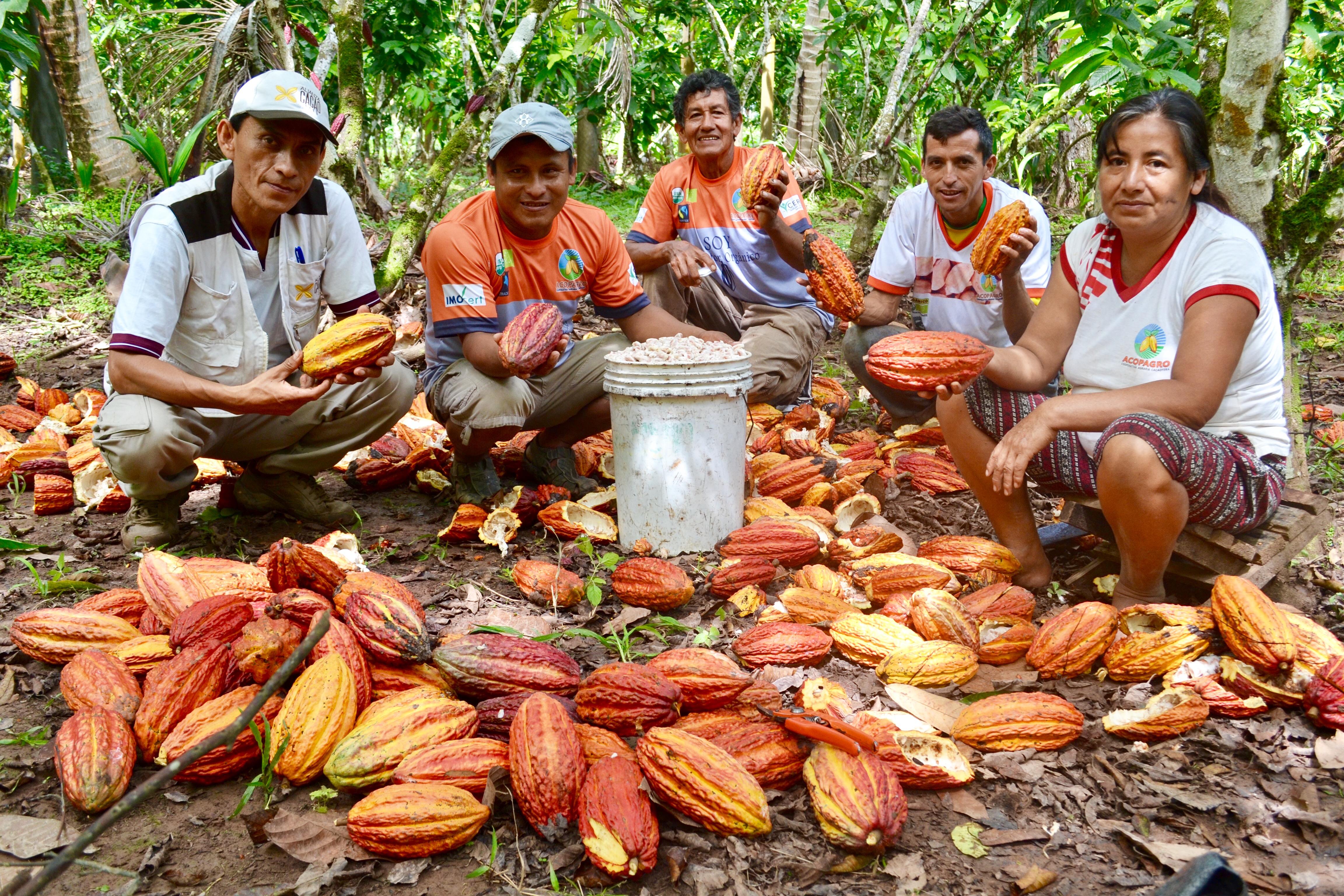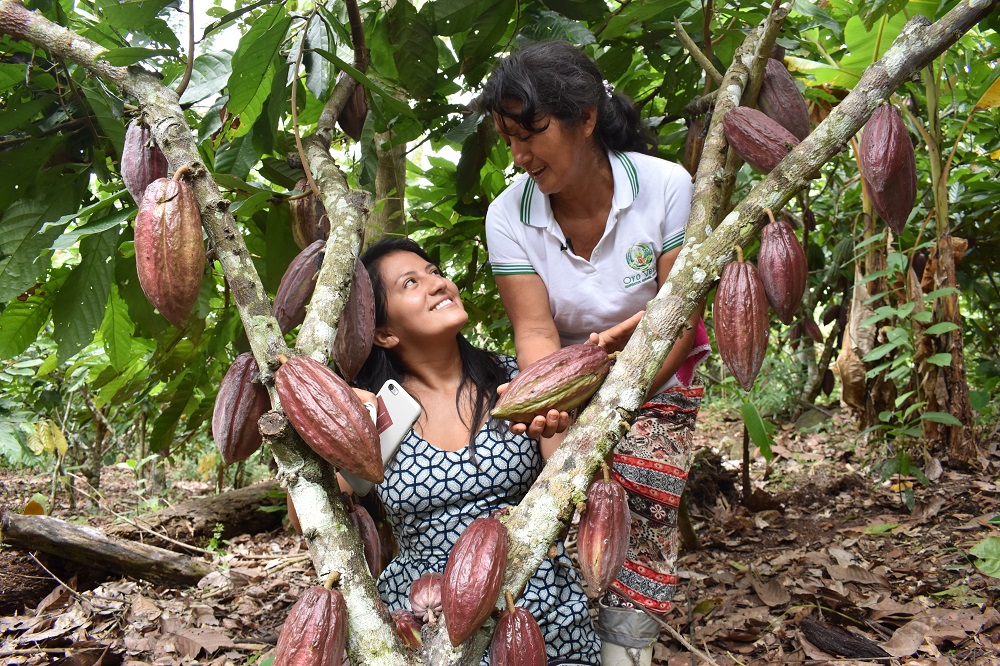with our monthly newsletter.
Peru Cocoa Alliance
In just seven years, Peru has become a significant player in fine-flavor cacao, moving from the tenth to the second largest specialty producer in the world. Palladium's Amanda Fernandez and Dr. Jose Iturrios Padilla of the Peru Cocoa Alliance write for the World Cocoa Foundation about what it took to make this shift possible.
Why should farmers continue to toil in a cycle of poverty? And what would it take to promote investment in the modernization of an inefficient system that was not working for anyone? These questions hung in the air during a 2011 assembly of key Peruvian cacao stakeholders. It was clear that the transformation of the cacao ecosystem required two principal strategic thrusts (1) providing a clear pathway out of poverty for farmers while (2) putting Peru on the map as a reliable source of high quality, sustainable cacao.
Seven years later, the Peru Cocoa Alliance (PCA or “the Alliance”) has shifted Peru from a marginal to a significant player in fine-flavor cacao, moving Peru from the tenth to the second largest specialty producer in the world, while also demonstrating new models that make cacao a viable business for farmers and other commercial actors in the system. Business solutions such as facilitated financing, technology upgrades and dispersed market information are bettering thousands of lives.
Long-Term Sustainability Starts with a Pathway for Farmer Viability
The Alliance, a USAID-supported public-private partnership implemented by Palladium, is executing a strategy to help farmers expand from an average of one hectare to at least five hectares (with a current average of about three) while raising productivity from 600 kg/ha to over 1,200 kg/ha. The supply chain gains additional value by facilitating investment in centralized post-harvest processing, which together with the development of fine-flavor profiles, will increase prices per unit (already an average of 20-30% higher per kg). This three-pronged strategy, namely 1) an increase in 25,000 hectares of higher yielding fine flavor cacao, 2) multiple Supply Chain Managers aggregating and processing high quality beans, and 3) direct links to buyers, will result in value increases of perhaps 10 times across the value chain.

The farmers are not philanthropic beneficiaries but rather full-fledged business partners, investing in their own plots and associations and making commitments to intermediate Supply Chain Managers and end-buyers. At the same time, input and technology companies finally see small-scale cacao farmers as a promising market. End buyers are positioned to work with Supply Chain Managers (both farmer associations and commercial firms) in developing long-term supply relationships, creating a virtuous circle of value creation.
New Organizational Models with the Private Sector: Technological Agents and the SCM Network
PCA is an incubator of new organizational models which align producers, cooperatives, aggregators, buyers, technology companies, exporters, chocolatiers and financial institutions to achieve scale based on mutually profitable business models. The Alliance began with four entities determined to streamline the underlying market system. Today, 35 members comprise PCA, with another 10 in the process of joining.
Two business models are particularly significant. The first consists of five technology and input companies working collaboratively in disseminating an integrated technology package while increasing sales in a cost-effective distribution system. With support from the Alliance, these companies—Yara, Husqvarna, Naandanjain, San Fernando and TABSAC—integrate their efforts in common demonstration plots and field schools while training and certifying lead farmers as “technological agents” who then acts as sales representatives for these companies. Post-sale activities for these agents include follow-up technical assistance to keep producers within their technological network. An interesting result has been the emergence of entrepreneurs offering technical services to the now expanding and modernizing farms, showing how the model independently builds upon itself.

The second innovation has been to focus on Supply Chain Managers that build direct relationships between groups of producers and end-buyers through a centralized post-harvest facility. This allows buyers to tailor the fermentation and drying protocols with these centralized facilities to fit their exact needs while also facilitating transparency and traceability in the supply chain. Some of these are business-oriented farmer organizations such as ACOPAGRO, Alto Huallaga, Allima Cacao, while others are privately-owned firms such as Romex, Ucayali River Cacao and AMT Agroindustria.
Facilitate Across the Board Financing
For input companies to sell to producers or Supply Chain Managers to invest in facilities and purchase product requires unlocking finance. The Alliance facilitates across-the-board financing by working with a variety of financial institutions including several commercial banks as well as impact investors such as Root Capital and Incofin. The new organizational models de-risk opportunities for financing post-harvest centers, aggregators and cooperatives, all of which now have a reliable source of cacao beans and a growing directory of enthusiastic off-takers. Likewise, the embedded extension model run by input providers and technology firms features on-the-spot financing tailored to the seasonal nature of cacao cultivation. Long-term buyers also invest down their supply chain, to better control production specifications and ensure reliability of supply and quality. Mobilized financing has allowed large-scale grafting of quality genetics, including over 25,000 hectares of new cacao, the majority of which are fine-flavor.
Farm Database Supports Traceability and Management
PCA operates a database that tracks varietals, region, and environmental and socioeconomic data by household and parcel of land. With 22,000 hectares geomapped and incorporated, this database can be linked to corporate supply chain management and traceability systems. It can also be used by finance institutions and farmer organizations to manage and support their farmers and their product in the specific catchment area. This allows chocolatiers to reduce certification costs and confidently market their products to tap higher markets that value regional diversity, ethical standards and quality.
Peru’s Transformation
With $62 million in private and public-sector investment to date, PCA has dramatically modernized the underlying market system. The Alliance manages a growing production network of 18,000 farming families and over 50,000 hectares, most just coming into full production. The economic and social success of participating farmers is encouraging further investment, including larger farms of up to 100 hectares. In the view of PCA and its members, sustainable cacao starts with viable farmers utilizing an environmentally sound agroforestry model, linked on a long-term basis to buyers, technology and finance.
Amanda Fernandez is Economic Growth Director at Palladium.
Dr. Jose Iturrios Padilla is National Director of the Peru Cocoa Alliance.
Additional contributors include Tim Freeman, Eduardo Tugendhat, Anne Szender, and Kat Cooley.
This article originally appeared at WorldCocoaFoundation.org and was republished with permission.
with our monthly newsletter.

